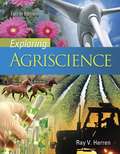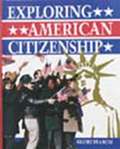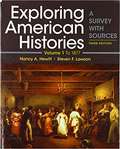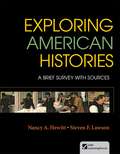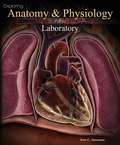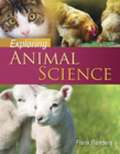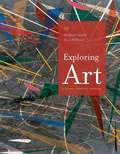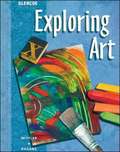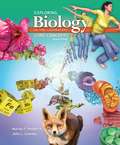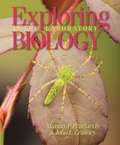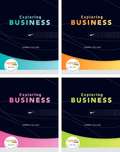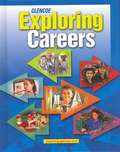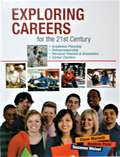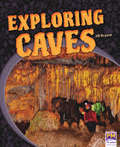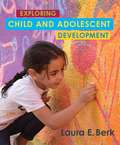- Table View
- List View
Explorers on the Move (Fountas & Pinnell Classroom, Guided Reading)
by Stephen Krensky Pete SmithNIMAC-sourced textbook. Fearless Frank and Hotfoot Harry are brave explorers traveling through dangerous places. Or are they two boys going home for a hot lunch?
Exploring America, Part 1 (Columbus to Reconstruction)
by Ray NotgrassThis curriculum will guide you through the story of our country from the first European explorers to the present. We place great emphasis on original documents and speeches because these allow the participants in history to tell the story from their own perspective. This curriculum also introduces some of the great literature that Americans have produced: novels, short stories, autobiographies, memoirs, essays, poems, hymns, and other kinds of writing. The written and spoken word has a profound ability to move hearts and minds. This course also explores the significance of faith with regard to history. Faith is connected with history in two ways. First, people have often been motivated to act because of their faith in God. For instance, faith motivated the Pilgrims on the Mayflower to seek a new land in which to live. Faith caused people to oppose slavery. Faith has been expressed often in the speeches and documents that Americans have produced. We recognize and highlight the importance of faith throughout the American story. A second way that faith should be connected to history is by looking at the overall story of American history through the eyes of faith. We encourage students to think about the faith lessons that they can learn from people and events in history. For instance, many God-fearing Americans owned slaves and had a strong prejudice against blacks. We need to understand what caused those Christian people to be blinded by their culture and how they missed the example of Jesus and the teaching of Scripture about this issue (see John 4:7-9, Galatians 3:28, and Ephesians 2:19). This might help us realize cultural blindnesses we suffer today. A study of history can inform, challenge, and strengthen our own faith. "
Exploring America, Part 2 (Late 1800's to Present)
by Ray NotgrassThis curriculum will guide you through the story of our country from the first European explorers to the present. We place great emphasis on original documents and speeches because these allow the participants in history to tell the story from their own perspective. This curriculum also introduces some of the great literature that Americans have produced: novels, short stories, autobiographies, memoirs, essays, poems, hymns, and other kinds of writing. The written and spoken word has a profound ability to move hearts and minds. This course also explores the significance of faith with regard to history. Faith is connected with history in two ways. First, people have often been motivated to act because of their faith in God. For instance, faith motivated the Pilgrims on the Mayflower to seek a new land in which to live. Faith caused people to oppose slavery. Faith has been expressed often in the speeches and documents that Americans have produced. We recognize and highlight the importance of faith throughout the American story. A second way that faith should be connected to history is by looking at the overall story of American history through the eyes of faith. We encourage students to think about the faith lessons that they can learn from people and events in history. For instance, many God-fearing Americans owned slaves and had a strong prejudice against blacks. We need to understand what caused those Christian people to be blinded by their culture and how they missed the example of Jesus and the teaching of Scripture about this issue (see John 4:7-9, Galatians 3:28, and Ephesians 2:19). This might help us realize cultural blindnesses we suffer today. A study of history can inform, challenge, and strengthen our own faith. "
Exploring American Citizenship
by Globe FearonThe Student Texts and Student Workbooks provide helpful charts, tables, and maps that allow students to look closely at all critical aspects of U.S. government, including citizenship, the justice system, foreign policy, and much more. The book helps students understand the development of the government and the rights and laws of local, state, and federal governments.
Exploring American Histories: A Survey with Sources (American Histories #1)
by Nancy A. Hewitt Steven F. LawsonOur book offers a new kind of U.S. history survey text, one that makes a broad and diverse American history accessible to a new generation of students and instructors interested in a more engaged learning and teaching style. To accomplish this, we carefully weave an unprecedented number of written and visual primary sources, representing a rich assortment of American perspectives, into each chapter.
Exploring American Histories: A Brief Survey with Sources
by Nancy A. Hewitt Steven F. LawsonThis book written in an innovative format makes broad and diverse American history accessible to students and instructors interested in a more active learning and teaching style.
Exploring American History
by John O'ConnorIn this book you will read the story of your country from its beginnings to the present day. The people who tell this story are called historians. You may wonder how historians find out what happened in the past. Historians are like detectives. They use many kinds of clues to learn about the way people lived and what they did in years gone by.
Exploring Anatomy & Physiology in the Laboratory
by Erin C. AmermanMany years ago, when I first started teaching anatomy and physiology, my biggest frustration with the course came from the laboratory. It seemed as if I were pulling teeth to get my students interested in the lab material and most students were unable to make the connections between lecture and lab.
Exploring Animal Science
by Frank B. FlandersEXPLORING ANIMAL SCIENCE offers educators the perfect tool for teaching animal agriculture: one that balances the academic background critical to building a strong foundation in fundamental science with the practical, production-oriented content vital to work in the real world. Its coverage spans a variety of areas like nutrition, anatomy and physiology, biotechnology, biosecurity, and genetics and animal reproduction. Each topic is presented in a straightforward manner that first investigates the basics, and then delves further into its practical application to the production, care, and management of animal agriculture. Ideal for a range of students, from late middle school to early high school, this unique approach is sure to engage by drawing such powerful connections between academics and real-life animal-based scenarios and situations. It also includes a wide range of activities that will fit any animal science classroom, making it an appealing choice for teachers and students alike.
Exploring Art: A Global, Thematic Approach
by Margaret Lazzari Dona SchlesierGiving you an appreciation for artworks and art styles across time and across the world, EXPLORING ART: A GLOBAL, THEMATIC APPROACH, 5E provides a solid foundation of art basics and then presents art through themes such as religion, power and politics, sexuality, mind and body, mortality and immortality, nature and technology, and entertainment and visual culture. "Art Experiences" features in every chapter and an all-new Chapter 15, "Art in Your Life," draw explicit connections between art and daily life, illustrating how art is all around us as well as providing suggestions for interacting with art. Timelines with thumbnail images help you easily draw chronological connections between works, and detailed world maps illustrate geographical relevance. In addition to new works by such artists as Tomatsu Shomei, Cindy Sherman, Doris Salcedo, George Rickey, Claude Monet, Georgia O'Keeffe, Hans Holbeing, James McNeill Whistler, Paul Klee, Giorgio de Chirico, Kay Sage, and Alexander Calder, the fifth edition offers expanded representation of contemporary artists from around the globe, including Julie Mehretu, Zaha Hadid, Ai Weiwei, Banksy, Anish Kapoor, Rafael Lozano-Hemmer, Do Ho Suh, Korczak Ziolkowski, and Marina Abramovic. Also available with the fifth edition, MindTap(tm) provides the ultimate personal learning experience through an interactive eBook, digital activities, author videos for each chapter, apps, and more.
Exploring Art
by Rosalind Ragans Gene MittlerEXPLORING ART takes a media approach to art, giving students insights into the ways artists are inspired, and the reasons they choose particular media to realize their artistic visions. Focusing on the elements and principles of art, students learn about various media and techniques, such as drawing, painting, printmaking and sculpting, as the chapters interweave compelling lessons on art, art history, aesthetics, and art criticism with opportunities for studio production.
Exploring Biological Anthropology: The Essentials
by Craig Britton Stanford John Scott Allen Susan C. AntónExploring Biological Anthropology: The Essentials combines concise coverage of the foundations of the field with modern innovations and discoveries, helping students understand, and get excited about, the discipline. Because the authors conduct research in three of the main areas of biological anthropology–the human fossil record (Susan Antón), primate behavior and ecology (Craig Stanford), and human biology and the brain (John Allen)–they offer a specialist approach that engages students and gives them everything they need to master the subject. The Fourth Edition continues to present traditional physical anthropology within a modern Darwinian framework, and includes coverage of contemporary discoveries to highlight the ever-increasing body of knowledge in biological anthropology.
Exploring Biology: An Inquiry Approach
by Frank A. Romano III William R. Bowen Benjamin G. Blair Stacy BlairExploring Biology: An Inquiry Approach Jacksonville State edition
Exploring Biology In The Laboratory: Core Concepts
by Murray P. Pendarvis John L. CrawleyExploring Biology in the Laboratory: Core Concepts is a comprehensive manual appropriate for introductory biology lab courses. This edition is designed for courses populated by nonmajors or for majors courses where abbreviated coverage is desired. Based on the two-semester version of Exploring Biology in the Laboratory, 3e, this Core Concepts edition features a streamlined set of clearly written activities with abbreviated coverage of the biodiversity of life. These exercises emphasize the unity of all living things and the evolutionary forces that have resulted in, and continue to act on, the diversity that we see around us today.
Exploring Biology in the Laboratory
by Murray Paton Pendarvis John L. CrawleyExploring Biology in the Laboratory is a comprehensive manual appropriate for one- or two-semester introductory general biology lab courses. Clearly-written and engaging activities emphasize the unity of all living things and the evolutionary forces that have resulted in, and continue to act on, the diversity that we see all around us.
Exploring Business
by Karen CollinsCollins is the only Introduction to Business book to teach students the topics of business through an in-depth study of a single company--Nike. How do you show your students the relationships between what they are learning in the classroom and what happens in the real business world? What happens when your students don't see the connections between the theory they are learning in the classroom and what is happening in the real business world?
Exploring Careers (4th edition)
by Joan Kelly-Plate Ruth Volz-PattonThis text prepares students for the rapidly changing opportunities in the world of work. As they explore each of the 16 U. S. Department of Education career clusters, they'll build foundation skills and workplace competencies as they learn how each new skill can help them build successful careers. Attractive visuals and an easy-to-read style invite students of all backgrounds and abilities to explore the content.
Exploring Careers and Financial Management for the 21st Century
by Steve Marietti Neelam Patel Suzanne WeixelCovers all New York State Career and Financial Management Objectives! Exploring Careers and Financial Management for the 21st Century
Exploring Careers for the 21st Century
by Steve Mariotti Neelam Patel Suzanne Weixel<i>Exploring Careers for the 21st Century</i> is a broad exploration of career opportunities and the rewards of different career pathways. It provides the essential tools that students need to set and achieve career and academic goals and make positive decisions that will affect their futures.
Exploring Caves (Into Reading, Level T #33)
by Jill BryantNIMAC-sourced textbook <p><p> Caves are dark, mysterious places. They are found all around the world, and they can be exciting places to explore. Find out about the deepest cave ever explored, the oldest paintings found on cave walls, and a cave that was used as a school!
Exploring Child and Adolescent Development (Berk, Exploring Child and Adolescent Development Series)
by Laura BerkLaura Berk’s most concise child development text! Exploring Child and Adolescent Development provides students with a clear, efficient survey of the most important concepts and research findings in the field of child development. In just 12 chapters, Berk makes classic, contemporary, and cutting-edge theories and research accessible in a manageable and relevant way, with an especially strong emphasis on real-world applications and an exceptional multicultural and cross-cultural focus. Chronologically organized, the text offers a complete introduction to the field, highlighting the most important concepts and research findings. This combination of rich content with concise presentation offers instructors unparalleled flexibility in designing their courses to meet both curricular and student needs.
Exploring Child Development
by Laura BerkExploring Child Development provides students with a clear, efficient survey of the most important concepts and research findings in the field of child development. In just 10 chapters, Berk makes classic, contemporary, and cutting-edge theories and research accessible in a manageable and relevant way, with an especially strong emphasis on real-world applications and an exceptional multicultural and cross-cultural focus. <p><p>Chronologically organized, the text offers a complete introduction to the field, highlighting the most important concepts and research findings. This combination of rich content with concise presentation offers instructors unparalleled flexibility in designing their courses to meet both curricular and student needs.

